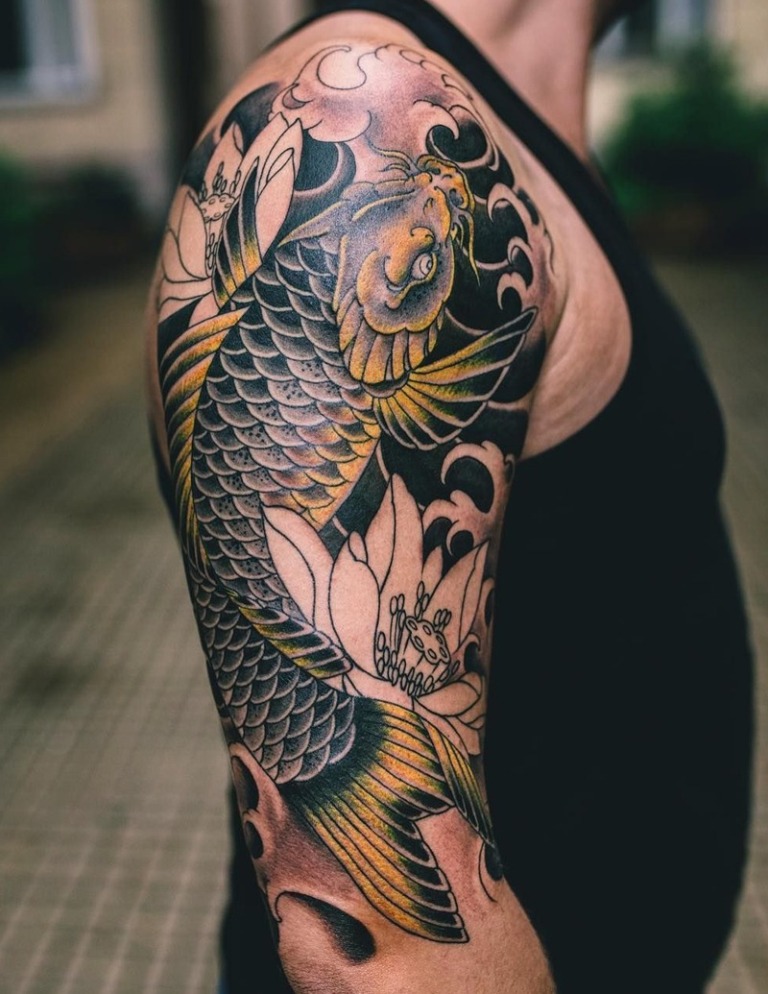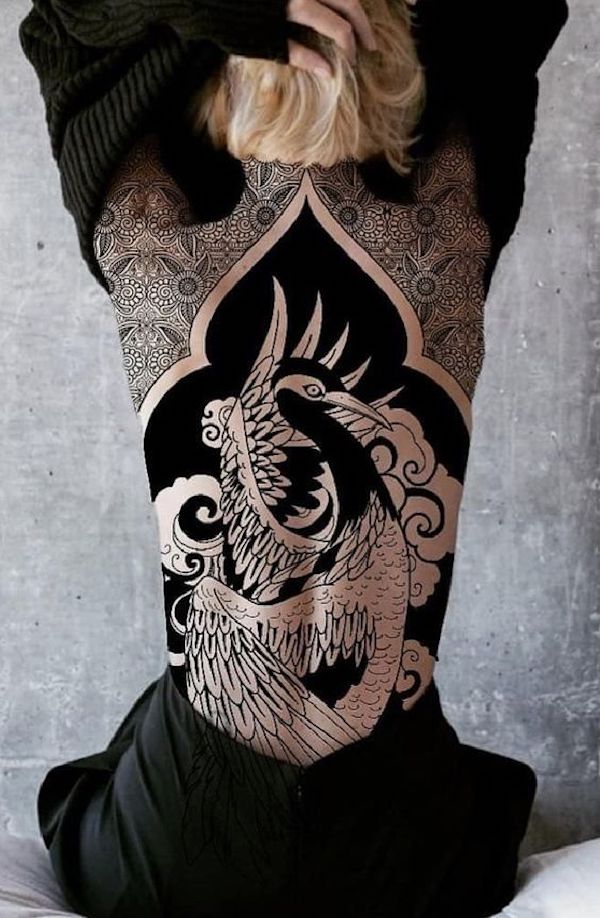Traditional Japanese Tattoo Designs for Your Back
Traditional Japanese Tattoo Designs for Your Back

Traditional Japanese Tattoo Designs for Your Back
Japanese tattoos are known for their bold colors, intricate designs, and deep symbolism. They have been around for centuries, and each design has its own unique meaning. If you're thinking about getting a Japanese tattoo, your back is a great place to put it.
There are many different traditional Japanese tattoo designs that you can choose from. Some of the most popular include:

- Dragons: Dragons are a symbol of strength, power, and good luck. They are often depicted in Chinese and Japanese mythology as powerful creatures that can fly and breathe fire.
- Tigers: Tigers are a symbol of courage, strength, and ferocity. They are often depicted in Japanese art as powerful guardians.
- Lions: Lions are a symbol of strength, power, and protection. They are often depicted in Japanese art as guardians of temples and palaces.
- Waves: Waves are a symbol of the ever-changing nature of life. They are often depicted in Japanese art as a reminder that nothing is permanent.
- Flowers: Flowers are a symbol of beauty, love, and new beginnings. They are often depicted in Japanese art as a way to celebrate the beauty of nature.
No matter what design you choose, a traditional Japanese tattoo is sure to be a beautiful and meaningful addition to your body.
Choosing a Japanese Tattoo Artist

When choosing a Japanese tattoo artist, it is important to find someone who is experienced in traditional Japanese tattooing. You should also make sure that you are comfortable with the artist's style and approach to tattooing.
Here are a few things to consider when choosing a Japanese tattoo artist:
- Experience: Make sure the artist has a lot of experience in traditional Japanese tattooing. This will ensure that they are able to create a high-quality tattoo that is true to the style.
- Style: Take a look at the artist's portfolio to see what their style is like. Do you like the way they draw and color? Do their tattoos look like traditional Japanese tattoos?
- Approach: Talk to the artist about their approach to tattooing. Do they take the time to listen to your ideas and work with you to create a custom design? Or do they just want to copy a pre-existing design?

Once you have found an artist that you are comfortable with, you can start the process of creating your Japanese tattoo.
Designing Your Japanese Tattoo
The first step in getting a Japanese tattoo is to design the tattoo. You can either work with the artist to create a custom design, or you can choose from a pre-existing design.

If you are working with an artist to create a custom design, be sure to give them as much information as possible about what you want. Tell them the size, location, and style of tattoo you are interested in. You can also provide them with images of Japanese tattoos that you like.
The artist will then use your information to create a custom design that is unique to you. They will draw the design on paper or digitally, and then they will show it to you so that you can make any changes that you want.
Once you are happy with the design, the artist will transfer it to your skin. They will do this by using a stencil or by freehand drawing the design.

Getting Your Japanese Tattoo
Getting a Japanese tattoo can be a long and painful process. The tattoo will need to be done in multiple sessions, and each session can take several hours.

The pain of getting a Japanese tattoo will vary depending on the size and location of the tattoo. The most painful areas to get tattooed are the ribs, the back, and the inner arm.


It is important to take care of your Japanese tattoo after it is done. This means keeping it clean and moisturized, and avoiding sun exposure.
Caring for Your Japanese Tattoo

After you get your Japanese tattoo, it is important to take care of it so that it heals properly. Here are a few tips for caring for your Japanese tattoo:


- Keep it clean. Wash your tattoo with soap and water twice a day.
- Moisturize it. Apply a thin layer of moisturizer to your tattoo several times a day.
- Avoid sun exposure. Keep your tattoo covered from the sun to prevent it from fading.
- Don't pick at it. Don't pick at your scabs or crusts, as this can damage your tattoo.
If you follow these tips, your Japanese tattoo will heal properly and look great for years to come.

Conclusion

Japanese tattoos are a beautiful and meaningful way to express yourself. If you are thinking about getting a Japanese
70 Traditional Japanese Back Tattoo Designs That Will Blow Your Mind
Japanese back tattoos are a popular choice for both men and women. They are often large and detailed, and they can incorporate a variety of traditional Japanese imagery. If you are considering getting a back tattoo, here are 70 traditional Japanese back tattoo designs that will blow your mind.

1. The Dragon
The dragon is a powerful and auspicious creature in Japanese mythology. It is often associated with strength, power, and good luck. Dragon tattoos are popular choices for men and women alike. They can be designed in a variety of styles, from realistic to traditional.
2. The Koi Fish

The koi fish is another popular Japanese back tattoo design. The koi is a symbol of perseverance, strength, and good fortune. It is said that koi fish can swim upstream against the current, and this symbolizes the ability to overcome obstacles in life. Koi fish tattoos are often colorful and vibrant, and they can be designed in a variety of styles.
3. The Phoenix
The phoenix is a mythical bird that is said to rise from the ashes. It is a symbol of rebirth, renewal, and hope. Phoenix tattoos are often associated with strength, courage, and overcoming adversity. They can be designed in a variety of styles, from realistic to traditional.

4. The Samurai
The samurai is a warrior who is honored and respected in Japanese culture. Samurai tattoos are often seen as a sign of strength, courage, and honor. They can be designed in a variety of styles, from realistic to traditional.
5. The Geisha

The geisha is a traditional Japanese dancer and entertainer. Geisha tattoos are often seen as a symbol of beauty, grace, and femininity. They can be designed in a variety of styles, from realistic to traditional.
6. The Maneki Neko
The maneki neko is a lucky cat that is often seen in Japanese homes and businesses. The maneki neko is said to bring good luck and fortune. Maneki neko tattoos are often seen as a symbol of good luck and prosperity. They can be designed in a variety of styles, from realistic to traditional.

7. The Sakura
The sakura is a cherry blossom tree. The sakura is a symbol of beauty, fragility, and renewal. Sakura tattoos are often seen as a symbol of hope and new beginnings. They can be designed in a variety of styles, from realistic to traditional.
8. The Kitsune

The kitsune is a fox spirit that is often seen in Japanese folklore. The kitsune is a symbol of cunning, intelligence, and mischief. Kitsune tattoos are often seen as a symbol of good luck and protection. They can be designed in a variety of styles, from realistic to traditional.
9. The Oni
The oni is a demon that is often seen in Japanese folklore. The oni is a symbol of fear, anger, and violence. Oni tattoos are often seen as a symbol of strength and power. They can be designed in a variety of styles, from realistic to traditional.

10. The Hannya
The hannya is a female demon that is often seen in Japanese folklore. The hannya is a symbol of jealousy, rage, and obsession. Hannya tattoos are often seen as a symbol of strength and power. They can be designed in a variety of styles, from realistic to traditional.
11. The Fudomyo-o


The fudomyo-o is a guardian deity that is often seen in Japanese temples. The fudomyo-o is a symbol of strength, power, and protection. Fudomyo-o tattoos are often seen as a symbol of protection and good luck. They can be designed in a variety of styles, from realistic to traditional.
12. The Benkei

The benkei is a warrior monk who is often seen in Japanese folklore. The benkei is a symbol of strength, courage, and loyalty. Benkei tattoos are often seen as a symbol of strength and power. They can be designed in a variety of styles, from realistic to traditional.


13. The Namazu
The namazu is a giant catfish that is said to live under the Japanese islands. The namazu is a symbol of earthquakes and natural disasters. Namazu tattoos are often seen as a symbol of good luck and protection. They can be designed in a variety of styles, from realistic to traditional.

14. The Yama-uba


The yama-uba is a mountain witch that is often seen in Japanese folklore. The yama-uba is a symbol of fear, danger,.